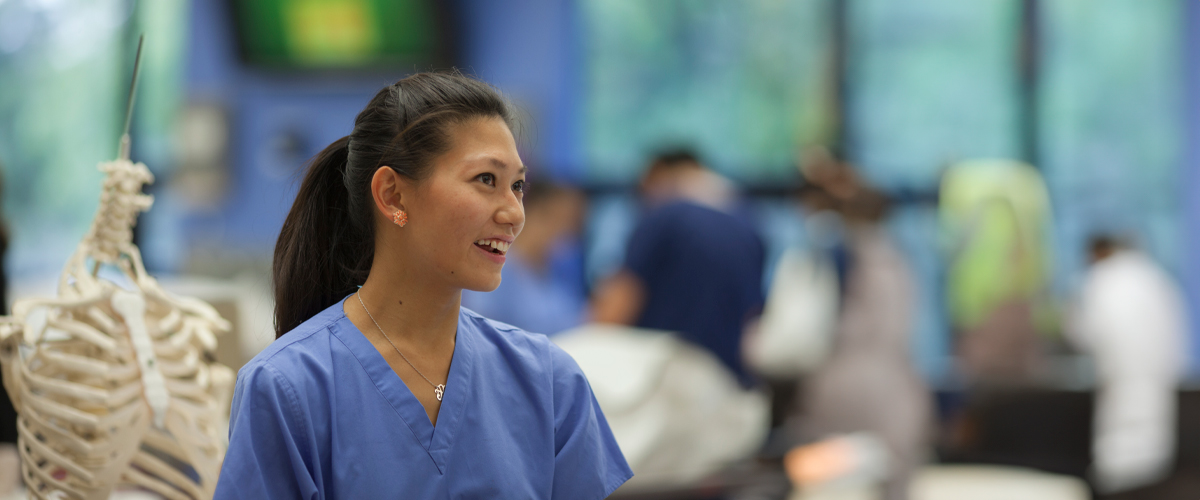
Labs & Facilities
Teaching & Learning Facilities
The New York Tech College of Osteopathic Medicine (NYITCOM) provides a range of labs, facilities, and resources that enhance the learning and teaching experience for all our students and faculty.
ANATOMY LAB
Explore the human body in our anatomy lab. The anatomical knowledge you learn here will provide a solid footing for your clinical skills and knowledge.
COLLEGE OF OSTEOPATHIC MEDICINE LIBRARY
Search our database of academic and research resources on campus or online. We offer 10,000+ medical and health publications, 400+ journals, videos and software, laptops for checkout, and professional reference assistance.
FERRARA CENTER FOR PATIENT SAFETY AND CLINICAL SIMULATION
The Ferrara Center for Patient Safety and Clinical Simulation consists of virtual patient exam rooms and simulation labs where you’ll practice interprofessional healthcare with New York Tech medical and health professions students.
OMM LAB
Learn to diagnose injury and illness while promoting the body’s natural ability to heal using osteopathic manipulative techniques. Our OMM lab features adjustable tables, natural lighting, and HD monitors that record and help evaluate your performance. Small group learning is encouraged via iPad-driven large-screen stations that allow access to online materials including over five hundred instructional videos.
PARKINSON’S CENTER
The Adele Smithers Parkinson’s Disease Treatment Center was created with one goal in mind: to improve the quality of life for patients and their families suffering from this disease. As a student, you’ll learn how practitioners across several medical specializations collaborate to treat patients with Parkinson’s disease.
Research Facilities
Our labs and core facilities support the exciting and innovative medical school research activities that have resulted in the publication of our research results in many peer-reviewed biomedical/clinical journals, including Science and Nature, and the awarding of multiple research grants from the National Institutes of Health, the National Science Foundation, and other funding agencies to our faculty members. Student access to these facilities is limited to those who are participating in related faculty-led research projects.
ANIMAL FACILITY
Our animal facility houses zebrafish and small rodents for research projects ranging from renal development to heart disease.
CELL CULTURE CORE FACILITY
The Cell Culture Core assists medical school researchers in a wide range of studies ranging from the genetic variations present in human diseases. Most research projects are supported by NIH awards.
GENOMIC & MOLECULAR BIOLOGY CORE FACILITY
Explore the genetic basis of health and disease and use molecular biology techniques to manipulate living cells and animals.
HISTOLOGY CORE FACILITY
Investigate the expression of proteins and functional activities at the cellular and tissue levels.
IMAGING CORE FACILITY
Probe biomedical research questions ranging from protein localization and movement in normal versus disease cells to the diet of prehistoric dinosaurs.
PALEONTOLOGICAL SPECIMEN PREPARATION CORE FACILITY
Unlock secrets of the prehistoric past using microscribe stations and other advanced equipment that help you examine fossils and other ancient finds. Also, check out our 3-D printer that lets you build virtual models of anatomical specimens.
PHYSIOLOGY CORE FACILITY
Learn to perform advanced medical techniques, such as echocardiography, invasive hemodynamic measurements, and vivo cardiac electrophysiology testing in small rodents.
Resources
ACADEMIC TECHNOLOGIES GROUP
The Academic Technologies Group provides instructional technology support to NYITCOM faculty, staff, and students.
STATISTICS SUPPORT
Our staff statistician and epidemiologist offer support services that include study design and data analysis.
ADDITIONAL EQUIPMENT
Many NYITCOM facilities share equipment to enhance their collaborative research efforts. These include centrifuges, digital imaging systems, and a biomechanics motion capture system.